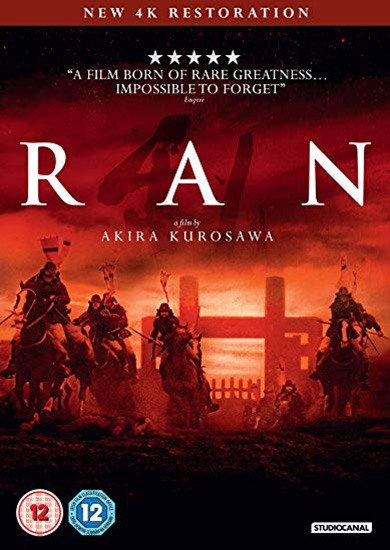Ran
One of Kurosawa's masterpieces. Set in 16th Century Japan, an elderly warlord retires, handing over his empire to his three sons. However, he vastly underestimates how the new-found power will corrupt them, or cause them to turn on each other... and him. This is a reinterpretation of Shakespeare's King Lear.
Film Notes
They don't make them like Akira Kurosawa's magisterial "Ran" anymore, but the truth is, they didn't really make them like this regal epic back then either. Now screening for one week on the Nuart's big West Los Angeles screen in a new 35 mm print struck to mark the picture's 25th anniversary as well as the centennial of the director's birth, "Ran" reminds us what a singular gift director Kurosawa had. His films stood out from the crowd then, and they do even more so now. Inspired by Shakespeare's "King Lear" in the same way Kurosawa's "Throne of Blood" was influenced by "Macbeth," "Ran" was the rare foreign language film to not only get multiple Oscar nominations, including best director, but to actually take home a statuette (for costume design). Kurosawa was attracted to tales from Shakespeare because they suited his particular gifts as a filmmaker. What's remarkable about "Ran" is that the drama enhances the spectacle the same way the spectacle bolsters the drama. Few other directors had Kurosawa's ability to convey the intimate as well as the epic, to handle stillness as well as violence. "Ran" (the title means "chaos" or "turmoil") is set during the constant warfare of 16th century Japan. The Lear-type figure is Hidetora, referred to as the Great Lord and convincingly played not by Kurosawa regular Toshiro Mifune but by the protean Tatsuya Nakadai, a bad guy in "Yojimbo" and "Sanjuro," and an unforgettable psychotic killer in "Sword of Doom." Nakadai's graybeard Hidetora is introduced at the top of his game, every inch the aristocratic warrior as he intently draws back an arrow during a boar hunt. At the lunch after the hunt, however, he reveals his 70-something age by dozing off and soon after he makes a surprise announcement: He's going to divide his kingdom and its three castles among his three sons. Only one son, the blunt and forthright Saburo (Daisuke Ryu), speaks his mind, calling the plan downright foolish and getting banished for his trouble. As "Ran" unfolds slowly but inexorably over its 2 hours, 42 minutes, we gradually see how right he was. In addition to changing Lear's daughters to Hidetora's sons, "Ran" makes interesting modifications to the story. For one thing, it takes pains to give Hidetora a specific back story of bloodshed and destruction that poisons his plans. For another, Kurosawa and co-screenwriters Hideo Oguni and Masato Ide create the spectacularly chilling character of Lady Kaede (Mieko Harada), the wife of Hidetora's eldest son, a seductive schemer who has issues of her own with her husband's family and no compunction about seeking revenge. A fascination with this kind of psychological portraiture was one of Kurosawa's strengths from Day 1. How people act, their motivations and character traits, are of primary importance here. It's the bond that holds "Ran" together and makes protagonists from this long-ago world accessible to us today. What people remember most about "Ran," however, are its bravura visuals, the detailed way Kurosawa and his team created this specific milieu. The director had each of half a dozen competing armies color-coded in terms of their gear, and Oscar-winning costume designer Emi Wada spent three years creating 1,400 costumes. Kurosawa mandated that authentic-to-the-16th century weaving and dying techniques be used, not blinking when it added $1 million to the budget. The centerpiece of the film is a six-minute battle scene daringly conceived with no sound or dialogue on the soundtrack, only Toru Takemitsu's unnerving score. The action is choreographed and shot with such unnerving skill by Kurosawa's trio of Oscar-nominated cinematographers -- Takao Saito, Mashaharu Ueda and Asakazu Nakai -- that we feel both immersed in the battle and an eavesdropper on reality. It doesn't get better than that.
Kenneth Turan Los Angeles Times March 05, 2010
One of the early reviews of Akira Kurosawa's "Ran" said that he could not possibly have directed it at an earlier age. My first impulse was to question that act of critical omnipotence. Who is to say Kurosawa couldn't have made this film at 50 or 60, instead of at 75, as he has? But then I thought longer about "Ran," which is based on Shakespeare's "King Lear" and on a similar medieval samurai legend. And I thought about Laurence Oliver's "Lear" on TV last year, and about the "Lear" I saw starring Douglas Campbell a few weeks ago here in Chicago, and I realized that age probably is a prerequisite to fully understand this character. Dustin Hoffman might be able to play Willy Loman by aging himself with makeup, but he will have to wait another 20 years to play Lear. The character contains great paradoxes, but they are not the paradoxes of youth; they spring from long habit. Lear has the arrogance of great power, long held. He has wide knowledge of the world. Yet he is curiously innocent when it comes to his own children; he thinks they can do no wrong, can be trusted to carry out his plans. At the end, when his dreams have been broken, the character has the touching quality of a childlike innocence that can see breath on lips that are forever sealed, and can dream of an existence beyond the cruelties of man. Playing Lear is not a technical exercise. I wonder if a man can do it who has not had great disappointments and long dark nights of the soul. Kurosawa has lived through those bad times. Here is one of the greatest directors of all time, out of fashion in his own country, suffering from depression, nearly blind. He prepared this film for 10 years, drawing hundreds of sketches showing every shot, hardly expecting that the money ever would be found to allow him to make the film. But a deal was finally put together by Serge Silberman, the old French producer who backed the later films of Luis Bunuel (who also could have given us a distinctive Lear). Silberman risked his own money; this is the most expensive Japanese film ever made, and, yes, perhaps Kurosawa could not have made it until he was 75. The story is familiar. An old lord decides to retire from daily control of his kingdom, yet still keep all the trappings of his power. He will divide his kingdom in three parts among his children. In "Ran" they are sons, not daughters. First, he requires a ritual statement of love. The youngest son cannot abide the hypocrisy, and stays silent. And so on. The Japanese legend Kurosawa draws upon contains a famous illustration in which the old lord takes three arrows and demonstrates that when they are bundled, they cannot be broken, but taken one at a time, they are weak. He wishes his sons to remain allies, so they will be strong, but of course they begin to fight, and civil war breaks out as the old lord begins his forlorn journey from one castle to another, gradually being stripped of his soldiers, his pride, his sanity. Nobody can film an epic battle scene like Kurosawa. He already has demonstrated that abundantly in "The Seven Samurai," in "Yojimbo," in "Kagemusha." In "Ran," the great bloody battles are counterpointed with scenes of a chamber quality, as deep hatreds and lusts are seen to grow behind the castle walls. "King Lear" is a play that centers obsessively around words expressing negatives. "Nothing? Nothing will come to nothing!" "Never, never, never." "No, no, no, no, no." They express in deep anguish the king's realization that what has been taken apart never will be put together again, that his beloved child is dead and will breathe no more, that his pride and folly have put an end to his happiness. Kurosawa's film expresses that despair perhaps more deeply than a Western film might; the samurai costumes, the makeup inspired by Noh drama, give the story a freshness that removes it from all our earlier associations. "Ran" is a great, glorious achievement. Kurosawa often must have associated himself with the old lord as he tried to put this film together, but in the end he has triumphed, and the image I have of him, at 75, is of three arrows bundled together.
Roger Ebert, Chicago Sun Times, December 25, 1985
IT would be difficult to imagine a more appropriate way to open the 23d New York Film Festival than with the two showings, which are scheduled for tonight at Lincoln Center, of Akira Kurosawa's 'Ran' ('Chaos'), a film of the sort of grandeur that brings to mind Griffith's 'Birth of a Nation,' 'Napoleon Vu par Abel Gance' and Eisenstein's 'Ivan the Terrible.' Though big in physical scope and of a beauty that suggests a kind of drunken, barbaric lyricism, 'Ran' has the terrible logic and clarity of a morality tale seen in tight close-up, of a myth that, while being utterly specific and particular in its time and place, remains ageless, infinitely adaptable. Kurosawa resists the description of 'Ran' as his 'version' of 'King Lear,' in the manner of his free, 1957 adaptation of 'Macbeth,' titled 'Throne of Blood.' However, he won't have an easy time disentangling his film from Shakespeare. According to Kurosawa, 'Ran' had its initial inspiration in the true story of a 16th-century Japanese warlord, which, as he worked on it, became increasingly associated in his imagination with the titanic fall of Shakespeare's Lear. There certainly are major differences between 'Lear' and 'Ran,' but there also are enough parallels to prompt comparisons, which may not always be illuminating. 'Ran,' at least as read in the English subtitles that translate the Japanese dialogue, is not a piece of dramatic literature. It's a visual masterwork whose manners, which sometimes look old-fashioned, recall virtually the entire history of epic cinema. Kurosawa's 'Lear' is Hidetora, the head of the Ichimonji clan, a once-ruthless, now-exhausted warlord who has spent his entire life subjugating his rivals and consolidating a vast dominion that he now, at the age of 70, wants to turn over to his three sons, on whose kindness he depends. Taro and Jiro, the two older sons, both ambitious, agree to their father's terms and swear loyalty to him and to each other. When Saburo, the youngest son, points out that by so dividing the lands, Hidetora is setting up conditions that will inevitably lead to disaster, the furious father sends Saburo into exile. Unlike 'Kagemusha,' Kurosawa's rather difficult-to-follow 1980 film, which the director has called a 'dry run' for the more elaborate and expensive 'Ran,' the politics and relationships in the new film are, though complex, always comprehensible. As in 'King Lear,' what, under other, far more ordinary conditions, would simply be a family squabble becomes a meditation on the human condition. By far the most interesting figure in this drama is not the foolish, pathetic old Hidetora, but his daughter-in-law Lady Kaede, the wife of his oldest son and principal heir, Taro. It's Kaede, the revenge-seeking daughter of one of the lords conquered by Hidetora, who urges her husband to humiliate his father, to disband his father's retinue and to assume full control of the family in his own name. Later, when Jiro, the second son, murders Taro, Kaede loses no time in staking her claims to Jiro, whom she seduces initially with her womanliness and then, when he shows signs of weakness, by holding a knife to his throat. Kaede is as implacable as she is beautiful. In one of the film's more extraordinary scenes, she stands by while Jiro, at her insistence, gives orders to an aide to bring to them the head of Jiro's legal wife, 'properly salted' so that it won't decompose during the long ride between castles. Kaede has no desire to be a concubine. She wants status as well as the power. She's a combination of Goneril, Regan, and Lady Macbeth, with a little bit of Barbara Stanwyck's Phyllis Dietrichson from 'Double Indemnity.' As played by Tatsuya Nakadai, Hidetora is not exactly a towering Lear, at least at the start. Mr. Nakadai seems initially too slight a man to have accomplished all the terrible deeds attributed to him. However, as the drama progresses, the actor seems to grow in stature, which has as much to do with what Mr. Nakadai does as with the increasingly phantasmagorical nature of the film itself. Cast out by his faithless sons, wandering, quite mad, across a volcanic plain, accompanied by Kyoami, his androgynous 'Fool,' Mr. Nakadai's Hidetora becomes an awesome, wraithlike figure. There is no attempt to play on sentiment. Hidetora is an angry ghost of someone not yet dead, a being who has looked in at the window of death and had it slammed in his face. When, toward the end, he cries out, 'I have tales to tell, forgiveness to ask,' everything we see - nature, landscapes, lighting, ominous cloud formations - conspires to allow the primal drama to leap over the inhibitions of the English subtitles to create a moment of remarkable cinema. The most memorable of the supporting performances are those of Mieko Harada, as the gloriously vicious, single-minded Lady Kaede, and of Peter, the stage name of the young transvestite actor-singer who plays Hidetora's Fool, not as an especially loving companion but as someone as trapped by fate as his master. The film's physical spectacle is astonishingly fine, the battle scenes so well integrated into the strong, inevitable story line that they never seem to become arbitrary set pieces - specialty numbers - the work of second-unit directors who know more about horses than actors. It's also meant as praise when I say that 'Ran' is very much an old man's movie - Kurosawa is 75 years old. (Hideo Oguni and Masato Ide, who collaborated with Kurosawa on the screenplay, are, respectively, 81 and 65.) Here is a film by a man whose art now stands outside time and fashion. 'Ran,' which will open here commercially in December, is a film that couldn't possibly have been made at any earlier period in this great director's career. POWER AND PATHOS RAN, directed by Akira Kurosawa; screenplay (Japanese with English subtitles) by Mr. Kurosawa, Hideo Oguni and Masato Ide; photography by Takao Saito and Masaharu Ueda with the collaboration of Asakazu Nakai; edited by Mr. Kurosawa; music by Toru Takemitsu; produced by Serge Silberman and Masato Hara; released by Orion Classics. At Alice Tully Hall, 7 P.M.; Avery Fisher Hall, 8:30 P.M., as part of the 23d New York Film Festival. Running time: 160 minutes. This film has no rating. Hidetora IchimonjiTatsuya Nakadai TaroAkira Terao JiroJinpachi Nezu SaburoDaisuke Ryu Lady KaedeMieko Harada Lady SueYoshiko Miyazaki IkomaKazuo Kato TangoMasayuki Yui KyoamiPeter FujimakiHitoshi Ueki KuroganeHisashi Ikawa TsurumaruTakeshi Nomura
By VINCENT CANBY the New York TimesSeptember 27, 1985
What you thought about Ran
Film Responses
| Excellent | Good | Average | Poor | Very Poor |
|---|---|---|---|---|
| 24 (46%) | 17 (33%) | 5 (10%) | 4 (8%) | 2 (4%) |
|
Total Number of Responses: 52 Film Score (0-5): 4.10 |
||||
Collated Response Comments
Thank you for your responses. We had an audience of 80 for Ran on a bitterly cold night and although many of you praised this “epic” and “magnificent film” which had “wonderful cinematography, costumes, music” and a storyline which was “heart breaking, sad and unforgettable,” many of you complained that it was “way too long!” However, the words “Exquisite” and “Stunning”, recurred most often, while “Brilliant” was close behind. Many of you told us that this was a “wonderful epic film - never less than riveting”, and “great to compare with Lear (having seen it at Stratford a month or so ago)”. There were other observations about the scale of the film with “no CGI gimmicks - Kurosawa being an artist himself, every scene was an art work. He is in a different league”. Some thought that the “battles were atmospheric but unconvincing” and overall that the film was “puzzling at times but powerful and engaging, needing a code for the army colours”. Other praise came in the following notes: “Wow it took a long time to get going but what an epic ending”. “A visual tour de force – riveted by the fabulous costumes, scenery and battle scenes – especially those that were accompanied by music”. “I have waited a long time to see this movie and wasn’t disappointed. Great cinematography. Gorgeous costumes”. “An epic piece of film making. Slow to start but then Wow”. “Genius”. “Well worth watching. A glimpse of old Japan”. “Good performances – fantastic battle scenes” “Rather long, with people running about in all directions, but given the genre it was visually stunning with many convolutions of the plot to hold the attention. Deservedly a classic, but of its time”. “Hard work, but I am glad to have seen this film. Music and soundtrack was haunting”. “Visually very exciting – the troops, the makeup and the costumes. Sparing use of music was excellent. I enjoyed the film much more than I had feared. Fraternal rivalry”. There were many symbols used during the film and one contributor asked “was the cuckoo on the soundtrack ironic?” and what did the “moth that lady Kaede catches in her cloak represent”. There is an excellent analysis and explanations of the symbolism of Ran and comparisons to Lear in a book by Alexander Leggatt for those of you that are interested, available on the Internet. One member said that it “certainly highlighted the absurdity and futility of mans endless need to wage war, a masterpiece” and another commented that “despite the length, the time passed quickly”. For others although it was an “impressive spectacle”, it “smothered the drama” and another member said that “Kurusowa is a brilliant film maker but the mores and honour obsession of a sad martial society alienated me to the entire world being portrayed”. While another said that they felt it was “seriously tedious. Shakespeare did it much better” and another’s conclusion was that it was “overly melodramatic, too long and the acting was laughable in places”.



